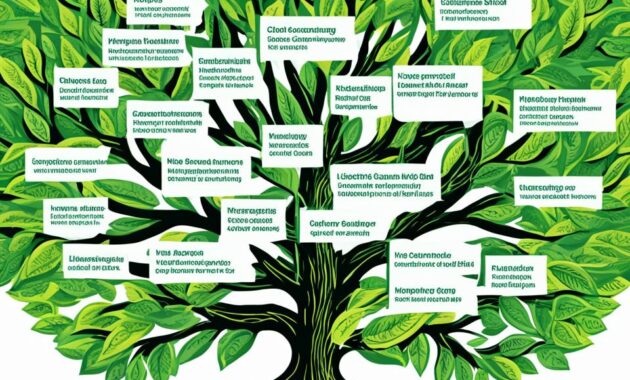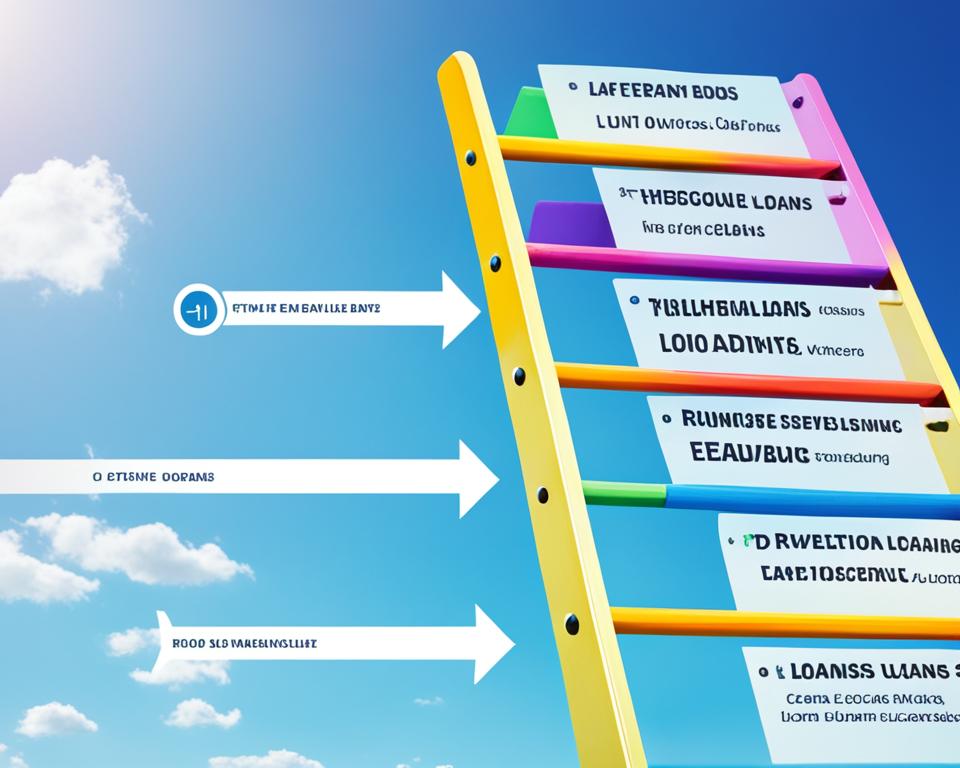Going to college in the United States is a big step, with high tuition and living costs. These costs have been going up, making it hard for students and their families to pay. But, there are many loan and aid options to help students pay for college.
This guide covers the many loan options for higher education in the USA. It talks about federal and private student loans, scholarships, grants, and work-study programs. By understanding these costs and aid options, students can make smart choices about paying for college.
This article also helps with the financial aid process, budgeting, and managing money in college. With the right info and planning, students can get the help they need for college and set up a bright future.
Key Takeaways
- Higher education in the USA is a significant investment, with rising tuition fees and living expenses
- Various student loan options are available, including federal loans, private loans, scholarships, grants, and work-study programs
- Understanding the costs and financial aid options is crucial for making informed decisions about college financing
- Navigating the financial aid process and budgeting effectively can help students manage their education expenses
- With proper planning and utilization of higher education loans and financial aid, students can successfully fund their college education and future goals
Understanding the Costs of Higher Education in the USA
When looking at higher education in the United States, it’s key to know the costs. Students and their families need to understand that costs go beyond tuition. Planning for all expenses is vital for a smooth college experience.
Tuition Fees and Other Expenses
Tuition is the main cost for college in the USA. But, students also need to plan for room and board, textbooks, transportation, and personal expenses. These costs can add up fast, so they should be part of the financial plan.
Room and board, which covers housing and meals, can be a big expense. Living off-campus might be cheaper, but remember to include utilities, groceries, and commuting costs. Textbooks and materials also have varying prices, depending on the subject and level.
Cost Variations Across States and Institutions
The cost of college in the USA can change a lot. Public colleges usually charge less for students from the state. But, students from other states pay more. Private colleges charge more, no matter where you’re from.
Living costs can also change a lot by state and region. Places like California and New York are pricier, affecting college costs. Elite private colleges also have higher fees and living costs than other schools.
| Institution Type | Average Annual Tuition and Fees |
|---|---|
| Public Two-Year College (In-District Students) | $3,770 |
| Public Four-Year College (In-State Students) | $10,560 |
| Public Four-Year College (Out-of-State Students) | $27,020 |
| Private Four-Year College | $37,650 |
The table shows tuition and fees can range from $3,770 for public two-year colleges to $37,650 for private four-year schools. It’s crucial for students and families to look into their school’s costs and plan financially.
Federal Student Loan Programs
The U.S. Department of Education offers several federal student loan programs. These loans have lower interest rates and flexible repayment options. They are a good choice for many students and their families. The main types are Direct Subsidized Loans, Direct Unsubsidized Loans, and Direct PLUS Loans.
Direct Subsidized Loans
Direct Subsidized Loans go to undergraduate students who need financial help. The U.S. Department of Education pays the interest while the student is in school, during the grace period, and during deferment. This lets students focus on their studies without worrying about extra interest.
Direct Unsubsidized Loans
Direct Unsubsidized Loans are for both undergraduate and graduate students, with or without financial need. The student pays all interest on these loans, which starts when the loan is given out. Students can pay the interest as they go or let it add up to the loan balance.
Direct PLUS Loans for Parents and Graduate Students
Direct PLUS Loans help cover extra education costs not covered by other aid. They are for two groups:
- Graduate and professional students
- Parents of dependent undergraduate students
To get a Direct PLUS Loan, the borrower must have a good credit history. If a parent can’t get a PLUS Loan, their dependent undergraduate student might get more Direct Unsubsidized Loan money.
| Loan Type | Eligibility | Interest Rate (2023-2024) |
|---|---|---|
| Direct Subsidized Loans | Undergraduate students with financial need | 4.99% |
| Direct Unsubsidized Loans | Undergraduate and graduate students | 4.99% (Undergraduate), 6.54% (Graduate) |
| Direct PLUS Loans | Graduate students and parents of dependent undergraduate students | 7.54% |
When looking at federal student loan options, it’s key to know the differences between them. These loans can help you reach your education goals. By using these loans and other aid, students can make their dreams of higher education come true.
Private Student Loan Options
In addition to federal student loans, private student loans are another way to pay for college in the U.S. These loans come from banks, credit unions, and other financial groups. They help cover costs that federal aid might not cover.
Eligibility Requirements for Private Loans
To get private student loans, you need a good credit score and steady income. Lenders look at these to see if you can pay back the loan. Here are some main requirements:
- A good credit score, usually over 650
- Steady income or a cosigner with stable income
- Being in an approved school program
- Being a U.S. citizen or permanent resident
If you don’t have much credit or a low score, having a cosigner can help. It can make you more likely to get approved. It might also give you better interest rates and repayment terms.
Comparing Interest Rates and Repayment Terms
When looking at private student loans, it’s key to compare rates and terms from different lenders. These loans often have higher rates than federal loans. The rates depend on your credit score, income, and other things.
Repayment options for private loans vary a lot. Some lenders offer flexible terms, like longer repayment periods or deferring payments while in school. Others have stricter terms, like needing to pay back right away or having few options to pause payments.
| Lender | Interest Rates (Fixed) | Interest Rates (Variable) | Repayment Terms |
|---|---|---|---|
| Sallie Mae | 4.25% – 12.59% | 1.25% – 11.10% | 5-15 years |
| Discover | 4.24% – 12.99% | 1.24% – 10.99% | 15-20 years |
| Wells Fargo | 4.00% – 10.72% | 2.50% – 9.22% | 5-20 years |
By looking at different lenders, you can find the best private student loan for your needs. This helps you pay for college while keeping costs down over time.
Scholarships and Grants: Free Money for College
Scholarships and grants are key to funding your education in the United States. They don’t need to be paid back, unlike loans. This makes them a great choice for students wanting to cut down on college costs. These aids can be given for academic success, sports, or art, or for those who really need it.
Merit-based scholarships are competitive and go to students who excel or show great promise. They come from colleges, private groups, foundations, and more. It’s important to look for scholarships that match your skills and interests.

Need-based grants go to students who really need them due to their family’s income and assets. The Pell Grant is a well-known federal grant for undergrads. Other federal grants include the FSEOG and the TEACH Grant.
“Investing in your education is one of the best decisions you can make, and scholarships and grants can help make that investment more affordable.” – Michelle Obama
Here are some tips to increase your chances of getting scholarships and grants:
- Start looking early and apply to many scholarships
- Customize your applications to show off your strengths
- Follow application rules and meet deadlines
- Look for scholarships from colleges, groups, and online
- Don’t give up if you’re rejected – keep applying
Putting in the work to find and apply for scholarships and grants can really help reduce your student loans. Every dollar matters for college, so explore all your options for free money.
Work-Study Programs: Earning While Learning
Work-study programs let students earn money while they study, making it easier to cover tuition, books, and living costs. These jobs are part-time and flexible, fitting around students’ class schedules. This way, students can manage work and study together smoothly.
Federal Work-Study Program
The Federal Work-Study Program is a government-backed program for students who need financial help. Colleges and universities run this program, offering jobs on and off campus at non-profits and public agencies. It helps students get work experience and covers some of their school costs.
“The Federal Work-Study Program has been a lifeline for me. It not only helps me pay for my education but also gives me practical work experience in my field of study.” – Sarah Johnson, University of California, Los Angeles
To get into the Federal Work-Study Program, students must:
- Fill out the Free Application for Federal Student Aid (FAFSA)
- Show they need financial help based on the FAFSA
- Be in an eligible program at school
- Keep up with their school’s academic standards
Institutional Work-Study Opportunities
Many schools also have their own work-study programs. These can have different rules and jobs than the federal program. They are paid for by the school. Jobs can be in libraries, research, tutoring, or helping out in the office.
Here are some benefits of these programs:
- Jobs fit around your class and study schedule
- Get work experience in your study area
- Work on campus, saving on travel costs
- Chance to network and get advice from professionals
Students wanting to join work-study programs should talk to their school’s financial aid office. They can learn about the jobs and rules. Being in these programs means getting work experience, improving your skills, and making money for school. All while keeping up with your studies.
Higher Education Loan in USA: A Comprehensive Guide
Looking into higher education loans in the United States can seem overwhelming for students and their families. There are many loans out there, each with its own rules, application steps, and ways to pay back. It’s key to know about these loans to make smart choices. This guide will cover the main parts of higher education loans, helping you find the right one for you.

Types of Higher Education Loans Available
There are two main kinds of loans for college: federal and private. Federal loans come from the government and usually have better terms and repayment plans. They include Direct Subsidized Loans, Direct Unsubsidized Loans, and Direct PLUS Loans for parents and grad students. Private loans come from banks and other lenders and can have different terms.
Eligibility Criteria and Application Process
To get a higher education loan, you need to meet certain requirements. These depend on the loan type, your student status, and your financial situation. For federal loans, start by filling out the Free Application for Federal Student Aid. This form shows your finances and helps figure out what aid you might get, like grants, scholarships, or loans. Private loans might ask for more info, like your credit score and income.
Loan Repayment Options and Forgiveness Programs
Understanding how to pay back your loans is key. Federal loans have different repayment plans, like:
- Standard Repayment Plan: Fixed payments over 10 years
- Graduated Repayment Plan: Payments start low and increase over time
- Extended Repayment Plan: Payments are lower over a longer time (up to 25 years)
- Income-Driven Repayment Plans: Payments based on your income and family size
Some borrowers can also get loan forgiveness programs. These, like Public Service Loan Forgiveness and Teacher Loan Forgiveness, can erase part of your debt if you work in certain fields or for non-profits.
Remember, loans can help finance your education, but borrow wisely and look at all your options before deciding.
Knowing about the different loans, their rules, how to apply, how to pay back, and forgiveness options will help you make smart choices. This way, you can pick a loan that fits your financial plans and career goals.
Navigating the Financial Aid Process
Getting financial aid makes higher education more accessible and affordable for many students in the U.S. By learning about the financial aid process and the resources available, students can get the support they need for their academic goals.
Completing the Free Application for Federal Student Aid (FAFSA)
The Free Application for Federal Student Aid (FAFSA) is the key first step in getting financial aid. It helps determine if a student can get federal grants, loans, and work-study programs. It’s important to fill out the FAFSA correctly and send it in on time to be considered for aid.
When doing the FAFSA, students and their families must share info about their income, assets, and other things that affect aid eligibility. This info helps figure out the student’s Expected Family Contribution (EFC). The EFC shows how much the family can afford to pay for education and helps decide if the student gets need-based aid.
Understanding Your Financial Aid Award Letter
After applying with the FAFSA, students get a financial aid award letter from the schools they got into. This letter tells them what aid they can get, like grants, scholarships, loans, and work-study.
It’s important to look over the award letter carefully and compare it with other schools’ offers to find the best deal. Pay attention to these parts of the letter:
- Types of aid offered (grants, scholarships, loans, work-study)
- Amount of aid offered for each type
- Expected Family Contribution (EFC)
- Cost of Attendance (COA) at the institution
Knowing about the financial aid process and the details in the award letter helps students make smart choices about paying for college. This way, they can keep their debt low.
“Navigating the financial aid process can be overwhelming, but with the right information and resources, students can unlock the door to a brighter future through higher education.” – Sarah Thompson, Director of Financial Aid at the University of California, Los Angeles
| Step | Description |
|---|---|
| 1. Complete FAFSA | Fill out the Free Application for Federal Student Aid accurately and submit by the deadline |
| 2. Review Award Letter | Carefully examine the financial aid award letter from each institution |
| 3. Compare Offers | Evaluate the aid packages from different institutions to determine the most affordable option |
| 4. Accept Aid | Accept the desired financial aid offered by the chosen institution |
Budgeting and Money Management for College Students
For college students, budgeting and money management are key skills. They help students keep track of their money and make sure they have enough for college expenses. Learning about financial literacy early on is important. It helps students make smart choices with their money and prepares them for the future.
When making a budget, students should think about all their income sources. This includes financial aid, part-time jobs, and help from family. They should also list all their expenses, like tuition, living costs, books, transport, and personal spending. Using budgeting tools, like spreadsheets or apps, can keep them organized and on top of their finances. These tools offer insights into spending and help find ways to cut costs.
Students should also focus on good money habits. This means avoiding too much credit card debt, saving for emergencies, and looking for student discounts. By following these student budgeting tips, college students can handle their money better and reduce stress. Learning to manage money well in college can greatly benefit their financial health after graduation.







